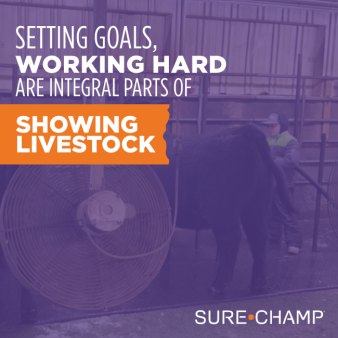
The time has come. You’ve traveled many miles, evaluated several dozen head of livestock, and made some significant purchases for your next show livestock projects. The animals are now in your barn, their new home, and it is time to get them tamed down and broke to lead so you can work with them. This should be the fun time, as you get to learn their unique personalities, their quirks and how they will likely be to work with the rest of the project season.
We reached out to four seasoned experts to get their top pieces of advice when working with new show livestock. After getting them and keeping them on feed and water and making sure they stay healthy, getting them acclimated is the next big step in your journey to #PreptoWin.
Kori Souter and her husband raise and sell show calf prospects in southeast Iowa. She is also the Area Sales Manager for BioZyme® Inc., in Iowa and offers her five top tips on breaking and taming calves.
- Buddy up your calf with another animal. This will help in speeding up the taming down process if the calf is not alone.
- Keep “new to you” calves in a smaller catch pen when you first get them “home,” for at least 24-48 hours, so they aren’t running. Be sure to include a Vita Charge® Stress Tub in the pen and add some Vita Charge Liquid Boost into their water source to help relieve stress and promote feed and water intake.
- The first few times you rinse them, loose rinse them in a small pen, as this will help tame them down greatly.
- Once you start the halter breaking process, let the calf drag the halter for a few days to get used to the rope being around its head.
- Be consistent. There are lots of processes and ways to do things, so find the method that works best for you and your family and be consistent to help keep your calf stress-free.
Cooper Bounds can be found just over the Mississippi River from Souter in western Illinois, where he raises Boer goats. When he isn’t raising and selling goats, he is the assistant coaching livestock judging at Western Illinois University. He offers some sound advice on getting goats broke to show.
- The most important thing is to get the goats settled, make sure they know what humans are and minimize their stress for the first week to 10 days.
- Move around the kids slowly and quietly, but get in the pen with them, so they get used to your presence. Let them smell you, see you and hear you to get familiarized with you. The more you interact with your new goats in their environment (their pen) that first week, the more familiar they are going to be with you and more comfortable they will be when it is time to work with them. It is all about establishing trust between the animal and the human.
- Even though goats show on a chain, it is easiest to move them around on a halter. To begin halter “breaking” them, make sure the halter is on properly around the goat’s jaw and ears, so it is comfortable, and the animal won’t slip out of it. Next, get it used to the idea of a halter by tying it up. Tie its head up snug so it can’t look around, but still make it comfortable for the animal. And don’t leave your goat alone. This is another opportunity for your goat to get used to you. While it is tied, talk to it, stay calm and work picking up its legs and setting them square, so it gets used to standing in that position.
- After about a week of daily tie-up sessions where the goat should be used to the halter, teach it to lead; for some goats this will come second nature, while others will need some added encouragement. Patience will be the biggest and most critical resource the exhibitor will need during this phase.
- Finally, while acclimating your goat to the chain, get it used to it on the standstill; then teach it to walk on the chain. Make sure to have it tight, right under the goat’s jaw. The chain helps with control, and once you teach your goat to walk, you can begin learning to set your goat square using the chain.
Even further east, Lori Lawrence in Ohio is another BioZyme ASM who has years of experience in the lamb barn. Her daughter was a successful lamb showman, and mom Lori served as her coach. She recalls her top tips for getting lamb projects familiar with their new surroundings.
- Slow and steady wins the race, so make sure you take each step one at a time. First, make sure to give them time to get used to their new environment, which includes their new barn, their new people and new sounds. Have the kids set in the pen with the lambs and read aloud or do their homework; play music or just talk to the lambs so they get used to their people and build trust.
- Another thing that helps build trust and simplifies the entire project is breaking the lambs to tie and lead with a halter. Not every sheep exhibitor does this, but if you can teach them to lead with a halter and tie up, it does help with control.
- When starting them on the lamb stand, make sure two people are there, one on each side, until that lamb is used to having its head in the rack. We had a five-head rack that was on the ground, and we used that piece of equipment more than anything to get lambs used to standing.
- Use technology! The exhibitor can’t always get the best view of his or her lamb but might think it looks dialed in when it is set up. We use videos and photos on our phone or tablet so our daughter can see exactly what the lamb would look like from the judge’s perspective when she was working with her animals. That way she could see how a leg needed moved or something needed adjusted when walking her animal.
- Keep the stress to a minimum, especially for the first few weeks until the lamb is accustomed to its surroundings. Try to keep dogs or other loud animals away from the lambs and avoid washing at first. If you keep blankets on year-round and that is something the lamb isn’t used to, check on the lamb frequently at first to make sure the blanket is staying on. If the lamb does seem stressed or does go off feed or water, give it a dose of Vita Charge® Gel.
Down in Oklahoma, Maverick Squires is another member of the ASM team for BioZyme. He also raises and sells show pig prospects. He offers his advice for getting new pig prospects used to their new environment and tamed down.
- Eliminate the stress of the new pig project as much as you can by putting it into an environment where it has the company of another animal, preferably a pig. Putting pigs in pens next to each other will help reduce stress.
- Get your new pig used to you by setting in the pen with it, getting it to come to you and just loving on it. Do this as often as you can for the first few days the new pigs are home. Once the pig is used to you, brush on it or just rub it down. Some people like to give their pigs treats like a marshmallow to get them tamed down in the pen.
- Start the walking process SLOWLY. Get your pig out of its pen for just a few minutes for the first few times to get it used to the whip or stick on one side of its body. If possible, have a parent or sibling get a second pig out to walk two pigs together, so the pig is not alone, reducing stress and making it more cooperative when it realizes it is not alone.
- Gradually increase what you are asking the pig to do each time you get it out of its pen. After a few times of walking it for a short duration with one whip, build up time, and start using two whips around its head to a) teach it to drive with its head up and b) learn how you, the exhibitor will control it and slow it down.
- When you have finished walking and working with your pig project it, reward it! Depending on your set up, the time of year and the temperatures, rinse it off or bathe it to get it cooled off, if the temperatures allow. If not, at the very least, rub it down and brush it so it gets used to that and to start working the skin and hair.
Regardless of the species, it is important to keep your animals calm, stress free and feeling their best, as you tame them down and get them broke to drive or lead in the first few weeks at your barn.

